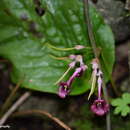pt-BR
nomes no trilho de navegação


Didymocarpus[1][2] is a genus of flowering plants in the family Gesneriaceae and typical of the tribe Didymocarpeae. There are about 100 known species distributed in India, Nepal, Bhutan, Myanmar, southern China, Vietnam, Laos, Cambodia, Thailand, and the Malay Peninsula, with one species extending up to northern Sumatra. Some members of the genus are known for their medicinal properties, especially to cure diseases related to the kidneys.[3]
The members of the genus are typically small perennial, deciduous herbs with annual flowering stems. Flowering shoots are produced from the basal rootstock or condensed rhizome during the onset of rainy season which dies after producing the fruits. Leaves are opposite, decussate and mostly unequal within pairs. The inflorescence is pair-flowered cyme, typical of the Gesneriad family, with few to many flowers. The calyx is often united for more than half of its length or rarely free to the base. The corolla is tubular, widening towards the mouth with a bilabiate limbs. The flowers are devoid of nectar are subtended by brightly colored bracteoles. Floral color can be hues of reds, oranges, yellows, and violet often with stripes on the lobes. The flower has two stamens with slender filaments and cohering anthers. The ovary is cylindrical with often with stipe and an entirely capitate stigma. Fruit capsules are straight, orthocarpic, bivalved, and dehisce loculicidally.
The genus Didymocarpus was described by Nathaniel Wallich in 1819 based on specimens he received from Nepal. Due to lack of a clear definition of the generic boundaries, more than 180 species and 450 names were affiliated to this genus over the time.[4] These included many morphologically distinct species from Madagascar, Western ghats of India and Southeast Asia. The genus was remodeled and redefined by Weber and Burt in 1998 with about 80 species. Recently, many new species were described from India, China and Thailand and the genus now comprises about 100 species.[5][6]
The Catalogue of Life lists:[2]
Didymocarpus is a genus of flowering plants in the family Gesneriaceae and typical of the tribe Didymocarpeae. There are about 100 known species distributed in India, Nepal, Bhutan, Myanmar, southern China, Vietnam, Laos, Cambodia, Thailand, and the Malay Peninsula, with one species extending up to northern Sumatra. Some members of the genus are known for their medicinal properties, especially to cure diseases related to the kidneys.